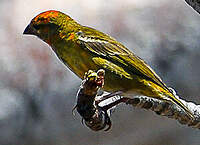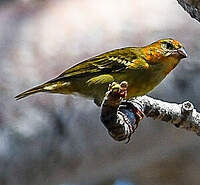Comoro Fody
Foudia eminentissima - Foudi des Comores
Identification
The Comoros Fody has a strong sexual dimorphism. In its nuptial plumage the male can be mistaken for other fodies in the Indian Ocean. It differs by having a restricted red colour on its head and chest. The lores, however, remain black. The belly is gray. The back and coverts are brown-black with large black streaks. The rectrices are also brown-black and the rump is uniform. The black and conical beak is stronger than that of the red fody. The iris is brown. The tarses and toes are pink.
The back of the female is identical to that of the male. The crown, nape and back are striped. The rump, the same colour as the back, is uniform like that of the male. The forehead is light with a slight eyebrow. The coverts have light brown streaks. The throat and breast are yellowish gray going towards a light gray on the flanks. The beak and tarses are pink-gray.
Males in eclipse and juveniles resemble females. At this stage, only bill and song can tell them apart from other fodies.
Subspecific information 4 subspecies
- Foudia eminentissima eminentissima (Mohéli)
- Foudia eminentissima consobrina ()
- Foudia eminentissima anjuanensis (Anjouan)
- Foudia eminentissima algondae (Mayotte)
Foreign names
- Foudi des Comores,
- Fodi cabecirrojo,
- foudia-das-comores,
- Komorenweber,
- vörösfejű fodi,
- Comorenwever,
- Fody testarossa,
- komorfody,
- Komorvever,
- fodia komorská,
- snovatec maskarenský,
- Comorervæver,
- maskareenienkutoja,
- fodi de les illes Comores,
- wikłacz komorski,
- Красноголовый фуди,
- シロハラベニノジコ,
- 马岛红头织雀,
- komorfody,
- 紅頭福迪雀,
Voice song and call
Habitat
The Comoros Fody can be found in forests except for those of Mayotte. However, it is very well adapted to bushy areas. Being a low altitude bird, it loves coastal, dry and bushy areas. There is no doubt that it can be encountered in mangroves and on beach edges, but only occasionally. It is also found in cultivated areas.
Behaviour character trait
Reproduction nesting
Geographic range
Threats - protection
Sources of information
- IOC World Bird List (v15.1), Gill, F and D Donsker (Eds). 2025-12-07.
- Oiseaux des iles de l'océan Indien, Langrand Olivier, ian Sinclair
- Les Oiseaux de Mayotte, Clément Michel, Grissac Philippe, Rolland Robin
- BirdLife International, BirdLife International
Other sources of interest
 Specification sheet created on
26/07/2023 by Nathalie Santa Maria
Specification sheet created on
26/07/2023 by Nathalie Santa MariaTranslation by AI Oiseaux.net
© 1996-2025 Oiseaux.net
- Accipitriformes
- Aegotheliformes
- Anseriformes
- Apodiformes
- Apterygiformes
- Bucerotiformes
- Caprimulgiformes
- Cariamiformes
- Casuariiformes
- Charadriiformes
- Ciconiiformes
- Coliiformes
- Columbiformes
- Coraciiformes
- Cuculiformes
- Eurypygiformes
- Falconiformes
- Galliformes
- Gaviiformes
- Gruiformes
- Leptosomiformes
- Mesitornithiformes
- Musophagiformes
- Nyctibiiformes
- Opisthocomiformes
- Otidiformes
- Passeriformes
- Pelecaniformes
- Phaethontiformes
- Phoenicopteriformes
- Piciformes
- Podargiformes
- Podicipediformes
- Procellariiformes
- Psittaciformes
- Pterocliformes
- Rheiformes
- Sphenisciformes
- Steatornithiformes
- Strigiformes
- Struthioniformes
- Suliformes
- Tinamiformes
- Trogoniformes












